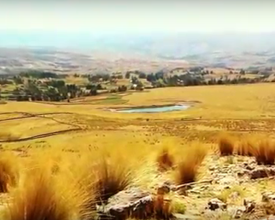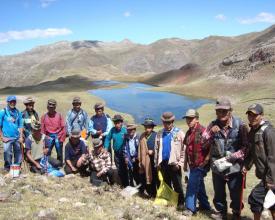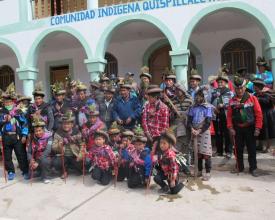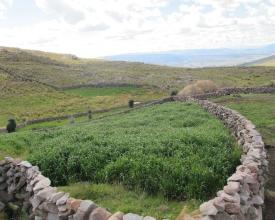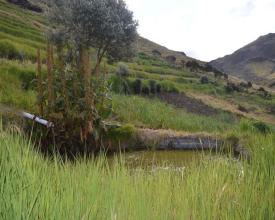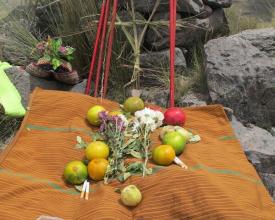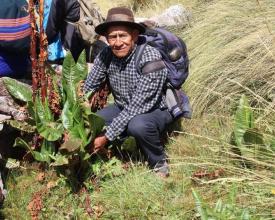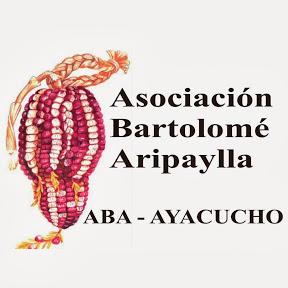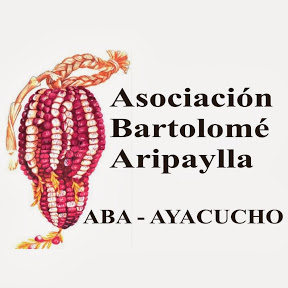
Rainwater harvesting for facing drought and soil moisture reduction and promoting ground water recharge
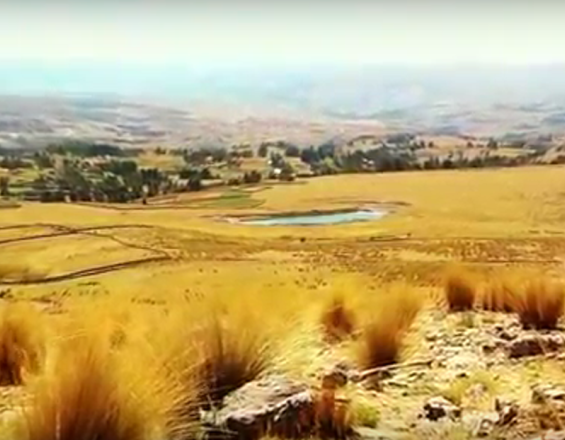
Rainwater harvesting („siembra y cosecha de agua de lluvia – SCALL“) is a hydrological technology of peasant farmers with a long-term vision. Its holistic approach is based on the Andean worldview called "water breeding” (“crianza de agua”). It is a collective practice in response to growing water scarcity. The experience combines green infrastructure with cultural, social and environmental practices as part of a program to recover Andean dry farming agriculture in harmony with the territory.
Contexte
Challenges addressed
The communities of the Chuschi district were the initial location of the armed conflict in the country (1980-2000). Their social and territorial organizational model was lost, submerging them in a deep crisis (damages and destructions, with their effects and consequences). Additionally, attempts to introduce inappropriate agricultural modernization practices in the territory, and increasing water scarcity for pastures and animals are complicating the situation. Rainwater harvesting aims at addressing these social and environmental challenges.
Beneficiaries
Direct: 4047 community members of Quispillaccta.
Indirect: 8400 inhabitants of Chuschi, Paras, Vinchos and Sarhua.
In addition, 45.000 consumers of drinking water of the city of Ayacucho and 9.000 commercial farmers in the lower part of the watershed.
Emplacement
Traiter
Summary of the process
The water harvesting includes a range of technical and cultural actions that are implemented within the framework of the process of recovery and strengthening of Andean peasant agriculture that the community has applied since 1991. This requires the interaction of the three building blocks: 1) Strengthening the local organization - valuing local knowledge and practices, 2) Maintenance of the farms and the landscape, 3) Recovery of collective rituals associated with water conservation and use.
Among these three components a network of dynamic interactions of mutual implications arises. The three components are mutually dependent in such a way that the ways in which each of them develops depends to a large extent on the others. All three involve social relationships, different forms of communication, information and affective networks. Nevertheless, it should be noted that the heterogeneity of the territory and the resulting worldviews are absolutely central and inherent in the whole process.
Building Blocks
Strengthening of local organizations
This building block is about the work with regard to the recovery and strengthening of the organization of the Ayllu (a form of extended family group) and the traditional authorities for farming. We have worked to revalue the knowledge of breeding, (climate) signals, cultivation practices and the so-called "secrets" to deal as much as possible with all the variety of situations and circumstances that are determined by the climate.
The methodological approach has allowed an intercultural dialogue and cultural mediation, as well as communal observation to build trust and transparency and a solid support system. The practice of mutual accompaniment composed of technicians committed to the processes of decolonization and cultural affirmation of diversity, was very useful. The facilitation and accompaniment of community initiatives and learning in the context of cultural dialogue, with shared responsibilities between the "target group" and the ABA team, generates very dynamic and effective reflection and action processes.
This has facilitated the capacity for adapting to change and empowered people to recognize themselves as main actors in development, based essentially on local resources and capabilities and affirmation of culture.
Enabling factors
Confidence in the community, which has allowed us to seek local solutions involving the key community members who maintain knowledge and ancestral practices.
The financing institution, ABA, forms part of the communal institutions and is recognized by the internal statutes of the Quispillaccta Indigenous Community. The members of its technical team belong to the community, which reinforces its indigenous coexistence with it and contributes to the positive Andean worldview.
Lesson learned
- The relationship with nature and cultural values has been strengthened, reinforcing a perspective of ecosystem service provision to the city of Huamanga.
- It has been important to recognize that there are two radically different worldviews, which requires a respectful conversation between both sides: On the one hand, a living, nature-related worldview that reaffirms life through nurture; and on the other, a technical, western world vision that reaffirms the extractive position with respect to nature and its "natural resources “.
- The communal and Ayllus organization is strengthened in order to face the climatic threats. Part of this is the revitalization of the traditional authorities, the Varayoc (mayor of indigenous community) takes care of the communal landscape and the surveillance of hail and frost. The strengthened local authorities enable the conservation of the natural environment.
Taking care of the farms and landscape
This includes the recovery and conservation of the diversity of cultivated plants and the knowledge related to their cultivation. In the surroundings, the fields and fences are created for animal breeding and to protect degraded areas. Also, practices were developed to increase the vegetation cover and to improve the infiltration and retention of humidity and the runoff in areas adjacent to the lagoons. These include:
- fencing areas without vegetation cover and sowing of native grasses in the communal grasslands,
- silvopastoral practices with fences to control overgrazing in hill areas and communal meadows,
- construction of terraces,
- afforestation and reforestation,
- closings with living fences,
- use of organic material,
- protection and conservation of emergent water springs,
- planting of plants that "call water",
- creation of ponds,
- celebrating the maintenance of water springs and dikes.
Ponds are created through construction of stone dikes with clay cores at the point of convergence of natural drainage or natural vessels in order to store the water that needs to filtrate and recharges the groundwater. (MINAGRI, 2015, b).
Enabling factors
Traditional knowledge systems are part of projects that aim at cultural affirmation. It is essential to restore the "mutual aid" groups Ayllus led by the Umas (leaders), mobilizing groups of common interest and enhancing the inherent abilities and roles of women, men, youth, children and the elderly for the recovery of the Andean peasant agriculture which cares for the water, the climate and the territory.
Lesson learned
This experience responds to a living and holistic worldview of the Andean peoples, which implies a different way of acting and relating to the territory and its elements. This is what we call mutual accompaniment, which is distinct and very different from the way of intervening in a development project or an irrigation project. It is important to highlight three key elements in relation to the water issue, which must be taken into account when implementing these measures in communities and with indigenous people:
- Take into account the living or "bio-cultural" dimension of the Andean territory. The living dimension of water or personalization of water based on the Andean worldview, local water culture, knowledge and “water breeding” secrets.
- The focus of traditional agriculture, biodiversity in the farm and its dispersion in the territory.
- Reciprocity or social support, community foundation and communal dynamics.
Recovery of rituals associated with the conservation and use of water
According to the worldview of Andean peoples like the Quispillaccta, the local world (or Pacha) is a living being populated by living beings and deities of all kinds. Everything that accompanies us in this world is perceived and conceived alive and a person with whom humans interact and talk. Water is a person with its own knowledge, and in moments of high emotionality it is Yakumama (Mother Water), and thus the relationship is conceived in terms of reciprocity.
The revitalization of collective rituals aims at recreating the human, with high sensitivity and capacity for open and continuous conversation, because only then will we be able to create the harmony that is convenient for all others (humans, nature and deities), and also let ourselves be raised by others. A ritual activity is nothing but a collective and collaborative action among all. It means that humans do ayni (cooperation, solidarity, mutual support) with nature and with the deities, which is what yarqa aspiy (cleaning of water channels) shows us: humans in reciprocal action with the water that celebrates its “birth”. Rituals for permission, visits to “water breeding” sites and rituals for calm waters are held in rainy years with the Yachaq (wise persons).
Enabling factors
- The presence of the Yachaq (wise persons with regard to water) and the families considered curious, since the “breeding of water” is an ancestral practice recovered from the collective memory in this place.
- The local strengths, promoted by a local team (ABA) that interacts with the community with motivating impacts.
- Dialogue of knowledge, strengthening confidence in the population’s own way and cultural affirmation.
Lesson learned
- The value of (traditional) knowledge and wisdom for adaptation to climate change is reinforced and practices and activities for “water breeding” is strengthened. Ritual practices for water breeding became revalued - to call for rain, to dispatch rain, when there is excess, as well as to cope with climatic phenomena such as icy hail, etc.
- Reciprocity not only serves to help families in agricultural production, but also provides guidance in all aspects, for example, in the health of the family, in the marketing of products, in the education of children, etc.
- One aspect that hinders the implementation of this component is the tendency towards an extractive view of water: The modern conception of water as a merely physical resource to be exploited through "irrigation projects" introduced to the communal agenda, hinders trust in their original believes. This has required a long process of communal reflection on it.
Impacts
The benefits are diverse, highlights include the formation of lagoons, recharge of springs, a better relationship with nature, valuation of culture and a perspective of ecosystem service provisions to the city of Huamanga.
Among the main impacts we have:
- 102 built rain gaps, which store approximately 2.000.000 m3 of water.
- Emergence of new springs (puquiales or ojos de agua – „fresh water eyes“), increased water flow of existing springs and permanence of those that were temporary.
- Water recharge rate increased by 54%; which generates a greater supply of water to the villagers and the city of Ayacucho during the year, compensating for the water deficit due to climate change.
- Increased vegetation cover by 51%; due to reduced grazing in open areas and reduced grazing hours. Consequently, improvement of the livestock production and better food supply and economic income of the families.
- Increase of available water or soil moisture between 55% to 75%.
- Reduced tensions between families and communities due to (better) access to water.
- Girls and women have more time available to perform other activities that were previously not allowed, such as recreation. Girls also attend school.
Sustainable Development Goals
Story
Rainwater harvesting is based on rainwater collection, like qucha chapay (“catching” water from temporary lagoons), qucha ruway (making new lagoons), and puquio waqaychay (nurturing springs).
The revitalization of collective rituals aims at the (re-)creation of a different human, with high sensitivity and capacity for open and continuous conversation, because only thus can we create the harmony that is convenient for all others (humans, nature and deities). Rituals are manifestations of respect and affection for everything, and a ritual activity is nothing but a collective and collaborative action among all. It means that humans do ayni (cooperation, solidarity, mutual support) with nature and with deities, which is what yarqa aspiy (cleaning of water channels) shows us: humans in reciprocal action with the water that celebrates its “birth”.
Without the social support and without the rituals, neither the conservation of biodiversity nor the maintenance of the landscape would be possible. Reciprocity serves not only to help families in agricultural production, but also provides support in all aspects such as in the health of the family, in the marketing of products, in the education of children.
Social support, agrobiodiversity on the farm and personal and communal well-being are positively reinforcing each other. These three components are generally related to human relations, and considered as a whole, it is an interweaving of regenerative actions.
Water “sowing” works by making the rain behave like seeds in the meadows, just like a seed of corn is deposited in a furrow, the rainwater is deposited in natural hollows.
Rainwater harvesting has allowed the dissemination of the practices of sowing and harvesting rainwater for the adaptation to climatic change - not only to face the dry season but also to face frost, hail and other climatic phenomena.
